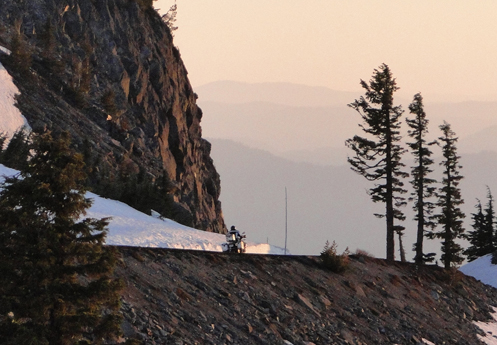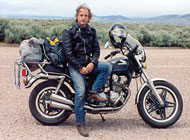Some Terrific National Parks To Ride In
Judy and I recently took a road trip that carried us to 10 national park system units, as they’re called. That is, these were national parks, national monuments, and a few others that go by “national historic site” and such. Growing up, my family would load up the car each year and take trips to national parks all over the country. On top of that, I just ended two and one-half years working at the National Park Service. They’re really in my blood, and Judy loves them, too.
There’s a saying that makes total sense here: They don’t put national parks in ugly places. So it’s no surprise that there are a lot of parks that are terrific for motorcycling. Here are some we visited on this trip.
We started out at Dinosaur National Monument, which we had also been to last year. Last year we did the middle section of the park and that was good for dual-sport bikes. This year we went to the west end. Not too much riding over there. Just some dinosaur bones to look at mainly.
Our next stop was Golden Spike National Historic Site. This is where they put in the golden spike connecting the transcontinental railroad. Very cool trains there but no riding.
On to City of Rocks National Reserve in Idaho, which is a very cool place. If you are on a dirt bike or dual-sport this would be a good place to go; the roads are not paved. We did see a couple people on dirt bikes.
Next was Hagerman Fossil Beds National Monument. Unfortunately there was little to see or do here because the research center/visitor center called for in the establishing legislation has never been funded.
And by the way, as an aside: if you have ever wondered why some places are national parks and some are national monuments, and some change from one to the other (Black Canyon of the Gunnison), here’s the very simple explanation. National parks are created by congressional legislation. National monuments are created by the president under the authority given under the Antiquities Act of 1906. In the case of the Black Canyon, some president declared it a monument and later Congress decided to make it a park. Now you know.
After Hagerman our next park was John Day Fossil Beds National Monument. As with several of these parks, the only reason I even knew they existed was because I edited their planning documents, primarily their foundation documents. In the JODA foundation (I’ll explain in a moment) there was discussion about the issue of the unwelcome noise created by lots of motorcycles. I took the liberty of rewording that text to make it clear that the issue was loud motorcycles as well as loud trucks or any other loud vehicles.
Anyway, that discussion in the foundation should be the tip-off: there are some terrific roads in John Day. A good bit of the park is centered on a couple steep canyons and we all know that steep canyons mean beautiful, twisty roads. And the bikers in Oregon know it. There were plenty of them. You owe it to yourself to check it out sometime if you’re up there.
And JODA? Another bit of inside information. National Park Service short-hand for the various park units is to take the first two letters of the first two words of the name. Thus, John Day Fossil Beds National Monument is JODA. Dinosaur National Monument is DINO, because they do not include the “national whatever” portion.
Then came Crater Lake. (That’s CRLA, you know.) However, long before we got to Crater Lake we were in the mountains of Oregon and there was nothing but great motorcycle roads. Western Oregon is just pretty dang beautiful.
As for Crater Lake, we actually came into the park on the longest, straightest road I’ve ever seen outside of crossing the Bonneville Salt Flats. But when you get up to the rim there is a road encircling the lake that is in the caldera of this volcano that blew its top long ago. This road is so twisty and narrow, with no shoulder and in most instances a pretty serious drop-off, such that we who are accustomed to mountain driving still found it a bit intimidating. Of course on a motorcycle it would we wonderful, as long as you look out for the terrified flatlanders hugging the center of the road and don’t try to look at the lake while you’re moving.
Going down from the rim and out the other side the roads are more interesting and twisty, the way you would expect coming off a mountain.
Not too far from Crater Lake is Oregon Caves National Monument and the only way to get there is to get off the main highway at Cave Junction and take a narrow, winding 19-mile road up the hill. Need I say more?
Heading south in to California we came to Lassen Volcano National Park. This place was a treat. There is a road that goes through the park and it takes you to most of the best places in the park. Climbing to great views, interesting stops. I definitely recommend Lassen (LAVO).
We blasted across Nevada and spent a night in Ely–you can’t beat the Hotel Nevada. Next morning it was on just a short distance to Great Basin National Park. They are two draws to Great Basin. The first is Lehman Caves, which is what initial land was set aside for and the name it used for many years. Then they expanded it to become what it is today. The second is the drive up 13,063-foot Wheeler Peak. Yeah, you guessed it, you’re going up a mountain. It’s a twisty narrow road with great views.
Our 10th and last park was Arches National Park. This is another of those that used to be a monument but was made into a park. I don’t know that there’s much advantage to seeing Arches on a bike versus a car, it’s the arches that are of interest and in almost every case you have to get out of the car or off the bike to go see them.
Then we headed home. So to sum it up, there are great motorcycle roads in six of these parks: DINO, JODA, CRLA, ORCA, LAVO, and GRBA. Get out there and do some riding!
Biker Quote for Today
I enjoy going on motorcycle trips and stopping in small towns and enjoying drinks with the locals. — George Clooney

